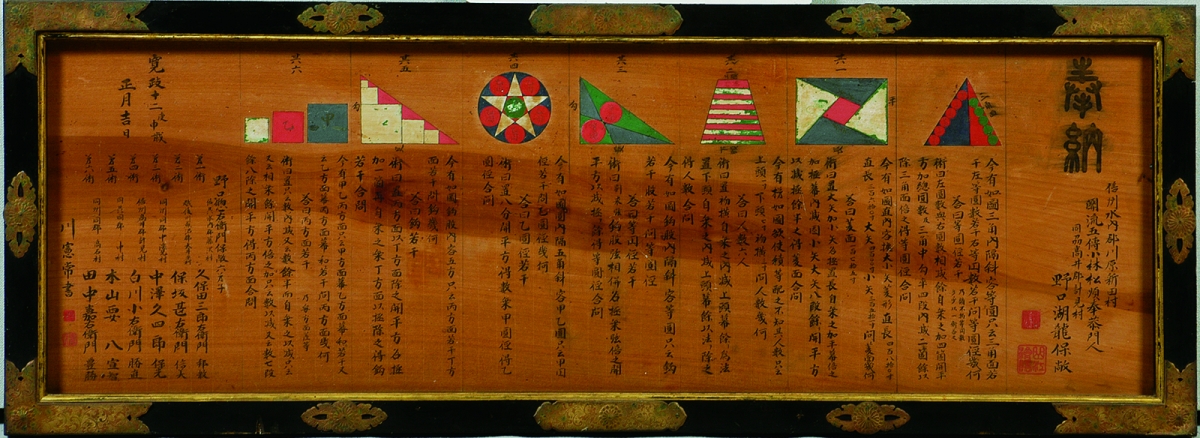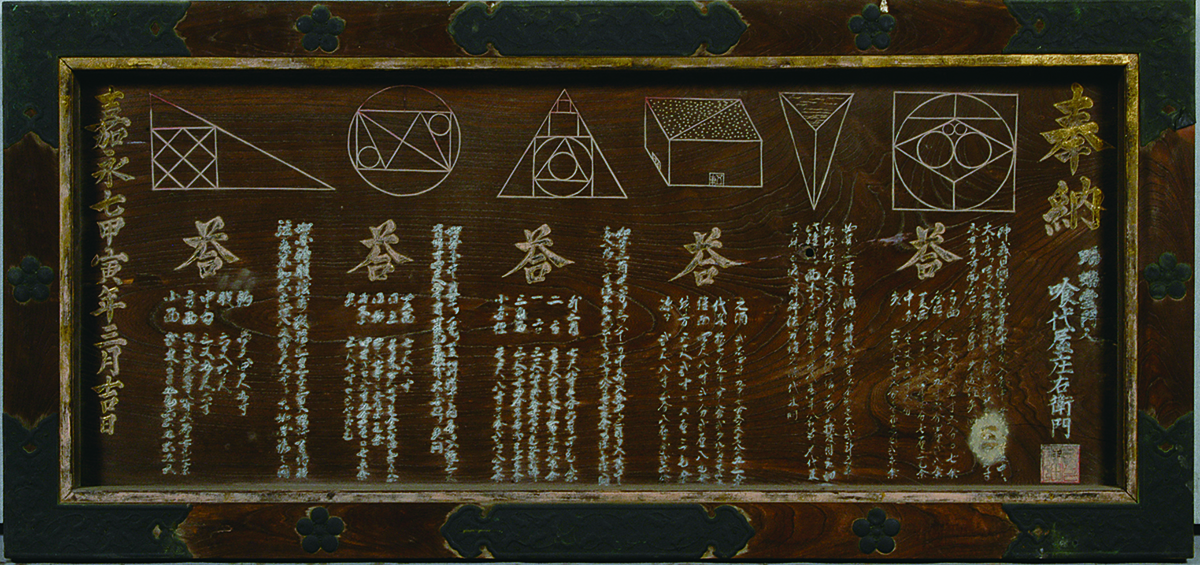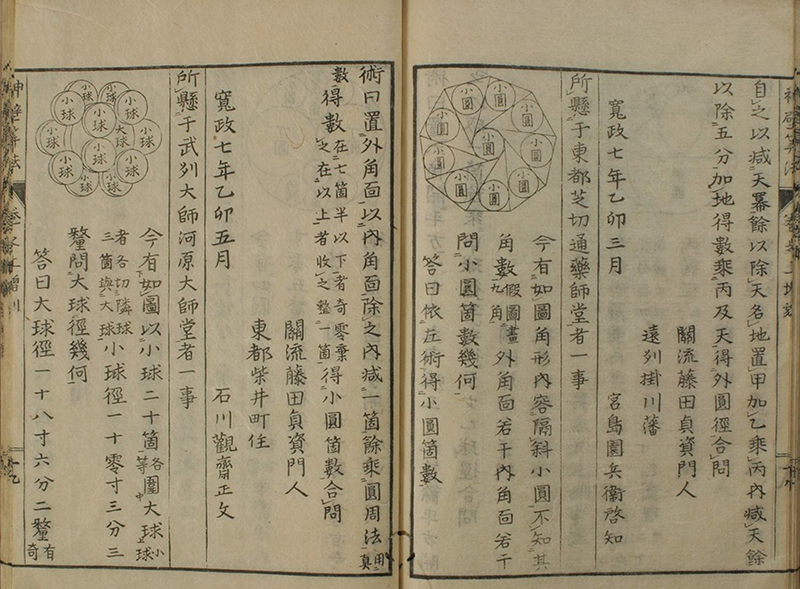- About MAA
- Membership
- MAA Publications
- Periodicals
- Blogs
- MAA Book Series
- MAA Press (an imprint of the AMS)
- MAA Notes
- MAA Reviews
- Mathematical Communication
- Information for Libraries
- Author Resources
- Advertise with MAA
- Meetings
- Competitions
- Programs
- Communities
- MAA Sections
- SIGMAA
- MAA Connect
- Students
- MAA Awards
- Awards Booklets
- Writing Awards
- Teaching Awards
- Service Awards
- Research Awards
- Lecture Awards
- Putnam Competition Individual and Team Winners
- D. E. Shaw Group AMC 8 Awards & Certificates
- Maryam Mirzakhani AMC 10 A Awards & Certificates
- Two Sigma AMC 10 B Awards & Certificates
- Jane Street AMC 12 A Awards & Certificates
- Akamai AMC 12 B Awards & Certificates
- High School Teachers
- News
You are here
Mathematical Treasure: Japanese Temple Mathematics

Formal mathematics in early Japan was adopted from Chinese sources, particularly the Chinese Jiuzhang suanshu (Nine Chapters on the Mathematical Art). The earliest known indigenous Japanese mathematical work, Jinkō-ki (Large and Small Numbers), appeared in 1627. Its contents focused on the use of algorithmic computational procedures in the solution of problems from daily life. Editions and variations of this work were published for the next three centuries. The illustration above, a woodcut print, is from a 1715 edition of Jinkō-ki intended for merchants, and promotes the use of an abacus, or soroban, in tallying merchandise. This image and the following images are provided through the courtesy of Fukagawa Hidetoshi and Tony Rothman and appear in their book, Sacred Mathematics: Japanese Temple Geometry (2008).

Above: A soroban (abacus) exercise from an 1818 edition of Jinkō-ki

Above: Illustration from the 1818 Jinkō-ki, which in its text asks the reader to supply two methods for determining the height of a tree: using trigonometry or using a stick of known length and similar triangles. The scene depicts two woodsmen, each using his own method to obtain the height of the tree. A similar problem is given in the 1627 edition:
We want to measure the height of a tree whose shadow is 15 syaku long. Near the tree, we erect a small stick 1.5 syaku tall and measure its shadow to be 0.5 syaku long. Find the height of the tree.
Mathematical problem posing and solving was popular in Japan during the Endo Period (1603-1861). Challenge problems were often carved on wooden plaques, like the ones below, and hung in temples and shrines for others to solve. These sets of challenge problems were called sangaku. In their book, Sacred Mathematics, Fukagawa Hidetoshi and Tony Rothman presented a history and collection of these problems. It is through the courtesy of these authors that the following images and problem translations are presented. Interested readers are urged to consult Sacred Mathematics for further information.

The sangaku above was hung in 1800 in the Mizuho Shrine in the town of Shimotakaigum. The third problem from the right in translation and modern notation reads as follows [Sacred Mathematics, p. 146]:
A trapezoid has lower side b, upper side a, and height h. Divide the area of the trapezoid into n small trapezoids of equal area. Call the lowest side of the smallest trapezoid k. Find n in terms of a, b and k.
This problem was posed by Hosaka Nobuyoshi in 1800.

Hojiroya Shōeman hung the sangaku above at the Sugrawara Tenman shrine of Ueno City in 1854. The first problem on the right side is translated as follows [Sacred Mathematics, p. 98]:
We have one circle inscribed in the outer square, a rhombus, two larger circles of radius R, and two smaller circles of radius r. The side of the rhombus b is the same length as the distance between the two horizontal lines drawn in the square. If 2r = 35.5, find a, a, b, R, and D.
Here, D is the perpendicular distance from the upper and lower vertices of the rhombus to the sides of the circumscribing square. It is advised to use the traditional Japanese value of π = 3.16 to solve this problem.
The first collection of sangaku were published by the Japanese mathematician Fujita Kagen (1765-1821) in his Shinpeki Sanpo (Sacred Mathematics) in 1789. These are pages from that book:

Reference
Fukagawa Hidetoshi and Tony Rothman, Sacred Mathematics: Japanese Temple Geometry, Princeton University Press, New Jersey, 2008.
Editor’s note: Frank Swetz's review of Sacred Mathematics appeared in Convergence in 2008. For another review, see MAA Reviews.
Frank J. Swetz (Pennsylvania State University), "Mathematical Treasure: Japanese Temple Mathematics," Convergence (September 2013)




